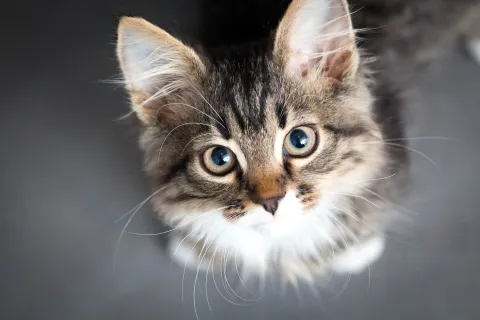Chronic kidney disease (CKD) is a leading health issue among senior cats, impacting up to 40% of cats over 10 years old and as many as 80% of those over 15. These vital organs filter waste from the blood, produce urine, regulate blood pressure, and maintain electrolyte balance. As CKD progresses, kidney function declines irreversibly, leading to serious complications. Age is the primary risk factor, making routine veterinary check-ups essential for older cats. Early detection can significantly improve quality of life and extend survival time.
For cat owners dealing with kidney concerns, exploring specialized nutrition options like the cat food for kidney disease pets at home can be a proactive step in supporting renal health.
Clinical Signs of CKD in Cats
Cats with early-stage CKD often show subtle or no symptoms because their bodies compensate effectively for reduced kidney function. As the disease advances, the kidneys struggle to concentrate urine, prompting cats to drink and urinate more frequently—a classic sign known as polyuria and polydipsia. This increased fluid loss can deplete essential proteins and vitamins, disrupting metabolism and causing weight loss, reduced appetite, and muscle wasting.
Waste buildup in the blood, termed uremia, leads to nausea, lethargy, and a dull, unkempt coat. Owners might notice their cat hiding more, vomiting occasionally, or having bad breath from toxin accumulation. Cats with CKD are prone to secondary issues like hypertension and anemia. High blood pressure, unregulated by damaged kidneys, can cause sudden blindness, disorientation, seizures, or heart strain. Anemia arises from diminished erythropoietin production—a kidney hormone crucial for red blood cell formation—resulting in pale gums, extreme fatigue, and further appetite loss.
Veterinary experts emphasize monitoring senior cats closely, as these signs mimic other age-related issues. For instance, a once-vibrant tabby might suddenly seem withdrawn, highlighting the need for prompt bloodwork. If your cat shows flaky or poor skin quality, which can accompany CKD-related malnutrition, consider supportive options like the best skin and coat supplement for cats.
Diagnosing Chronic Kidney Disease in Cats
Diagnosis relies on a combination of blood tests, urinalysis, and sometimes imaging, as no single test paints the full picture. Bloodwork measures key markers: blood urea nitrogen (BUN), creatinine, and symmetric dimethylarginine (SDMA). Elevated levels indicate azotemia, but context matters—dehydration or low muscle mass can skew results. Creatinine rises only after 75% kidney loss, while SDMA detects changes at 40%, enabling earlier intervention.
Urinalysis assesses urine specific gravity (USG), pH, protein levels (via UPC ratio), and screens for infections. Low USG signals poor concentration, an early CKD flag, though fluids can temporarily alter it. Urine culture rules out bacterial urinary tract infections, which mimic CKD symptoms. Samples are collected via litter box (non-absorbent pellets), catheterization, or cystocentesis—a safe needle aspiration from the bladder yielding the purest sample.
Additional tests evaluate electrolytes (sodium, potassium), phosphorus, anemia, and proteins. Blood pressure screening is critical, as 60% of CKD cats develop hypertension. Imaging like ultrasound or X-rays detects structural issues, while biopsies are rare. The International Renal Interest Society (IRIS) staging system—based on stable, hydrated samples—guides prognosis and treatment, factoring in proteinuria and blood pressure substages.
Learn more about the IRIS staging system. Comprehensive evaluation, often requiring two sets of tests two weeks apart, ensures accuracy.
Treatment and Management Strategies for CKD Cats
CKD has no cure, but tailored management slows progression and enhances life quality. Focus areas include toxin reduction, hydration, nutrition, blood pressure control, and anemia management.
Dietary changes are foundational. Prescription renal diets—low in protein, phosphorus, and sodium, high in omega-3s, antioxidants, and moisture—extend life by 2-3 times per studies from institutions like Cornell University College of Veterinary Medicine. Transition gradually over 7-10 days, warming food or mixing flavors to entice picky eaters. Wet formulas aid hydration; dry options suit some preferences. Dietary modification details underscore veterinary collaboration.
 Little fluffy kitten on a gray background
Little fluffy kitten on a gray background
Hydration is paramount; dehydration accelerates damage. Encourage intake with fountains, multiple bowls, or flavored water. Subcutaneous fluids at home (every 1-3 days) or IV in clinic stabilize advanced cases—many owners master this under vet guidance.
Medications target comorbidities: telmisartan (liquid) controls hypertension and proteinuria. Anemia treatments include injections (erythropoietin/darbepoetin) or oral molidustat, provided blood pressure is managed. Phosphate binders, potassium supplements, anti-nausea drugs (e.g., mirtazapine for appetite), and alkalinizers address imbalances.
Supportive therapies like natural remedies for cat digestion may ease gastrointestinal upset from uremia, complementing prescription care. Advanced options—hemodialysis or transplants—remain experimental and costly, best discussed with specialists.
Regular monitoring adjusts therapies, preventing crises.
Prognosis for Cats with Chronic Kidney Disease
Outcomes vary by IRIS stage, early detection, and response to therapy. Stage 2 cats average 2-3 years survival; Stage 4, under 6 months. Poor proteinuria control, high phosphorus, or anemia worsens prognosis. Early intervention yields the best results, with some cats thriving years post-diagnosis.
Consistent vet visits, owner diligence, and holistic care optimize longevity.
In summary, chronic kidney disease in cats demands vigilance, especially in seniors. Routine exams catch it early, when interventions like renal diets and fluids make the biggest difference. Consult your veterinarian for personalized plans—prompt action preserves your feline companion’s vitality. Explore more cat health tips on our site for comprehensive care guidance.
Updated November 2025
